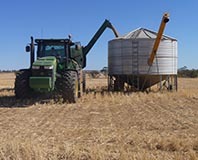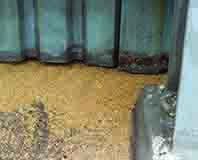Read the latest information on
Foot-and-mouth disease

Grain harvesting in full swing. Photo: Barry Large
Grain harvest has begun in the northern states of Australia, so it’s time to plan your harvesting down south.
Jim Moran, Grains Biosecurity Officer, says that you need to use a multi-step game plan rather than a single play when it comes to hygienic grain storage.
“What are your tactics to minimise insect infestations and maximise quality control and saleability of your crop?,” asks Mr Moran.
“You’ll win or lose money depending on how well it is implemented,” he said.
Jim advises growers that it all begins now, before harvest with a thorough Spring clean inside, outside and around all grain storage.

Spilled grain and other material may harbour insects
“Completely remove spilled grain, soil, weeds, plant residues and other material that may harbour insects.
“All machinery and equipment used to strip, transport, lift and store the grain also needs to be clean.”
Grain machinery and equipment should all be thoroughly cleaned before harvest with high pressure air or water, and then sprayed with a registered structural treatment at label rates. A popular structural treatment is a desiccant dust which is used instead of chemical structural insecticides which are also available.
“New infestations can arrive from the paddock with the freshly harvested crop, but there may also be insects in the equipment that will simply re-infest the new harvest if not treated now,” said Mr Moran.
The other key elements in your winning storage hygiene game plan include:

Aerate grain to quickly lower the temperature and slow the breeding of insects
For free hard copy of the Monitoring stored grain on farm booklet or the Biosecurity Manual for Grain Producers, contact Jim Moran at DEDJTR Bendigo on 03 5430 4479.
For more information and tips on how to implement farm biosecurity on your property go to the Grains section of the Farm Biosecurity website; or visit the Grains Research and Development Corporation web site grdc.com.au and search for ‘storage’.